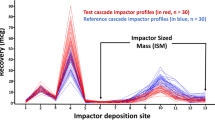Abstract
The purpose of this article is to report final results of the evaluation of a chi-square ratio test proposed by the US Food and Drug Administration (FDA) for demonstrating equivalence of aerodynamic particle size distribution (APSD) profiles of nasal and orally inhaled drug products. A working group of the Product Quality Research Institute previously published results demonstrating some limitations of the proposed test. In an effort to overcome the test’s limited discrimination, the group proposed a supplemental test, a population bioequivalence (PBE) test for impactor-sized mass (ISM). In this final report the group compares the chi-square ratio test to the ISM-PBE test and to the combination of both tests. The basis for comparison is a set of 55 realistic scenarios of cascade impactor data, which were evaluated for equivalence by the statistical tests and independently by the group members. In many instances, the combined application of these 2 tests appeared to increase the discriminating ability of the statistical procedure compared with the chi-square ratio test alone. In certain situations the chi-square ratio test alone was sufficient to determine equivalence of APSD profiles, while in other situations neither of the tests alone nor their combination was adequate. This report describes all of these scenarios and results. In the end, the group did not recommend a statistical test for APSD profile equivalence. The group did not investigate other in vitro tests, in vivo issues, or other statistical tests for APSD profile comparisons. The studied tests are not intended for routine quality control of APSD.
Similar content being viewed by others
References
FDA/CDER. Draft guidance for industry: bioavailability and bioequivalence studies for nasal aerosols and nasal sprays for local action. Food and Drug Administration Web site. 1999; Available at: http://www.fda.gov/cder/guidance/2070DFT.pdf. Accessed March 28, 2007.
Tsong Y. Statistical comparison of particle size distribution profiles. 2004; Available at: http://pqri.org/commworking/minutes/pdfs/dptc/psdpcwg/Addl/DC01-475116-v2-Yi_Tsong_Statistical_Archive_PQRI_Profile_Comparisons.DOC. Accessed June 22, 2007.
Tsong Y. Profile analysis of cascade impactor data: proposed FDA approach. Presentation to OINDP Subcommittee of the Advisory Committee for Pharmaceutical Science. Rockville, MD: US Pharmacopeia; April 26, 2000. Available at: http://www.fda.gov/ohrms/dockets/ac/00/slides/3609s1e.ppt. Accessed October 19, 2006.
United States Pharmacopeial Convention. Chapter 601. Aerosols, metered-dose inhalers, and dry powder inhalers. In:USP30-NF25. Rockville, MD: USP; 2007:220–240.
DeLuca PP, Lyapustina S. Product Quality Research Institute reports.AAPS PharmSciTech [serial online]. 2007;8:article 6.
Adams WP, Christopher D, Lee DS, et al. Product Quality Research Institute evaluation of cascade impactor profiles of pharmaceutical aerosols, Part 1: background for a statistical method.AAPS PharmSciTech [serial online]. 2007;8:article 4.
Christopher D, Adams WP, Lee DS, et al. Product Quality Research Institute evaluation of cascade impactor profiles of pharmaceutical aerosols, Part 2: evaluation of a method for determining equivalence.AAPS PharmSciTech [serial online]. 2007;8:article 5.
PQRI Profile Comparisons Working Group. Systematic study of 38 scenarios. 2005; Available at: http://pqri.org/commworking/minutes/pdfs/dptc/psdpcwg/Addl/38%20Systematic%20Scenarios.pdf. Accessed November 1, 2006.
FDA. CDER. Statistical information from the June 1999 Draft Guidance and Statistical Information forIn Vitro Bioequivalence Data Posted on August 18, 1999. Available at: http://www.fda.gov/cder/guidance/5383stats.pdf. Accessed January 14, 2007.
PQRI Profile Comparisons Working Group. Realistic scenarios 1–33 of 55. 2005; Available at: http://pqri.org/commworking/minutes/pdfs/dptc/psdpcwg/Addl/Realistic%20Scenarios%201-33%20of%2055.pdf. Accessed October 19, 2006.
PQRI Profile Comparisons Working Group. Realistic scenarios 34–55 of 55. 2005; Available at: http://pqri.org/commworking/minutes/pdfs/dptc/psdpcwg/Addl/Realistic%20Scenarios%2034-55%20of%2055.pdf. Accessed October 19, 2006.
PQRI APSD Profile Comparisons Working Group’s assessment. 2006; Available at: http://pqri.org/commworking/minutes/pdfs/dptc/psdpcwg/Addl/PQRI_APSD_Profile_Comparisons_Working_Groups_Assessment.XLS. Accessed June 22, 2007.
SAS Institute Inc.SAS System for Windows, Release 9.1 (TS1M3). Cary, NC: SAS Institute Inc; 2003.
PQRI APSD Profile Comparisons Working Group. SAS code implementing the chi-square ratio method. 2006; Available at: http://www.pqri.org/structure/psdp.asp. Accessed May 29, 2007.
PQRI APSD Profile Comparisons Working Group. Description of the PBE approach. 2007; Available at: http://www.pqri.org/commworking/minutes/pdfs/dptc/psdpcwg/Addl/DC01-526048-v1-PBE_Description_for_PQRI_Prof_Comp.pdf. Accessed May 29, 2007.
PQRI APSD Profile Comparisons Working Group. Minutes of the teleconference on 13 July 2005:3–8. Available at: http://pqri.org/commworking/minutes/pdfs/dptc/psdpcwg/071305min.pdf. Accessed March 28, 2007.
PQRI APSD Profile Comparisons Working Group. Qualitative descriptions with thumbnail plots of the 55 realistic scenarios. 2006; Available at: http://pqri.org/commworking/minutes/pdfs/dptc/psdpcwg/Addl/DC01-525635-v1-Thumbnail_plots_prof_comp_scenarios.pdf. Accessed May 17, 2007.
FDA/CDER. Second draft guidance for industry: bioavailability and bioequivalence studies for nasal aerosols and nasal sprays for local action.Food and Drug Administration Web site. 2003; Available at: http://www.fda.gov/cder/guidance/5383DFT.pdf. Accessed June 22, 2007.
Zanen P, Go LT, Lammers J-WJ. The optimal particle size for β-adrenergic aerosols in mild asthmatics.Int J Pharm. 1994;107:211–217.
Zanen P, Go LT, Lammers J-WJ. The optimal particle size for parasympathicolytic aerosols in mild asthmatics.Int J Pharm. 1995;114:111–115.
Zanen P, Go LT, Lammers J-WJ. Optimal particle size for beta 2 agonist and anticholinergic aerosols in patients with severe airflow obstruction.Thorax. 1996;51:977–980.
Usmani OS, Biddiscombe MF, Barnes PJ. Regional lung deposition and bronchodilator response as a function of β2-agonist particle size.Am J Respir Crit Care Med. 2005;172:1497–1504.
Lee Ds. Searching for the holy grail of a single PSD profile comparator. Respiratory Drug Delivery Conference IX; April 25–29, 2004; Palm Desert, CA. Available at: http://pqri.org/commworking/minutes/pdfs/dptc/psdpcwg/Addl/DC01-504108-v1-Identical Profiles_and_Stabilty_Slides.PPT. Accessed October 19, 2006.
Christopher D, Curry P, Doub B, et al. Considerations for the development and practice of cascade impaction testing, including a mass balance failure investigation tree.J Aerosol Med. 2003;16:235–247.
Author information
Authors and Affiliations
Corresponding author
Additional information
Published: November 2, 2007
Rights and permissions
About this article
Cite this article
Christopher, D., Adams, W., Amann, A. et al. Product quality research institute evaluation of cascade impactor profiles of pharmaceutical aerosols, part 3: Final report on a statistical procedure for determining equivalence. AAPS PharmSciTech 8, 90 (2007). https://doi.org/10.1208/pt0804090
Received:
Revised:
Accepted:
DOI: https://doi.org/10.1208/pt0804090




